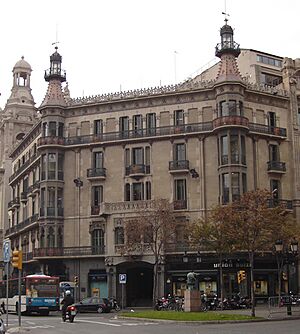Josep Vilaseca i Casanovas facts for kids
Josep Vilaseca i Casanovas (born in Barcelona, Spain in 1848, died in 1910) was a famous Spanish architect and artist. He was an important part of the Modernista art movement. This style was popular in Catalonia, Spain, around the late 1800s and early 1900s.
Contents
Josep Vilaseca's Early Life and Studies
Josep Vilaseca studied architecture in Madrid, the capital city of Spain. He finished his studies and became a qualified architect in 1873. After his studies, he traveled to Germany with another well-known architect, Lluís Domènech i Montaner.
In 1874, Josep Vilaseca started teaching at the Escuela de Arquitectura de Barcelona. This was a school for architecture students in Barcelona. He loved teaching and continued to work there for the rest of his life.
Famous Buildings by Vilaseca
One of Josep Vilaseca's most famous buildings is the Arc de Triomf in Barcelona. This grand arch was built for the 1888 Universal Exposition, a big world's fair held in the city. The Arc de Triomf shows how his style changed over time.
His work is a great example of how architecture in Catalonia moved from an older style, called neo-Classicism, to the newer Modernisme style in the late 1800s.
Other Important Works
Josep Vilaseca designed many other notable buildings. Here are some of them:
- Casa Vilaseca: Built in 1874 in Plaça Urquinaona. This building no longer exists today.
- Institucions Provincials de Cultura: He worked on this project with Lluís Domènech i Montaner in 1877.
- Casa Pia Batlló: Completed in 1901, this beautiful house is located on Rambla de Catalunya.
- Casa Comas i Argemí: This house was finished in 1909 on Avinguda de la República Argentina.
- Casa Cabot: Built in 1906, you can find these houses on Carrer de Lloria, number 8.
- Cases Batlló: These houses are on the corner of Carrer Mallorca and Passeig de Gràcia.
- Casa Bruno Quadros: This building is located on La Rambla, a famous street in Barcelona.
See also
 In Spanish: José Vilaseca y Casanovas para niños
In Spanish: José Vilaseca y Casanovas para niños



